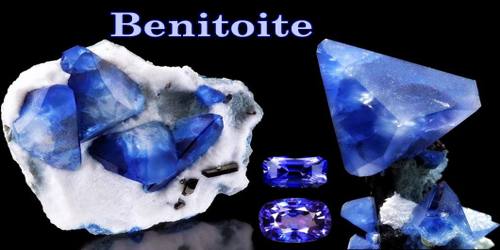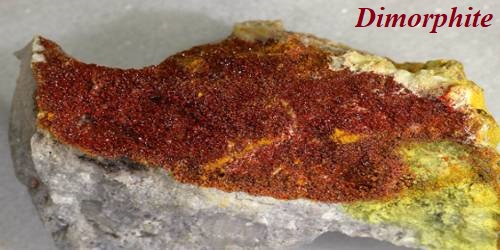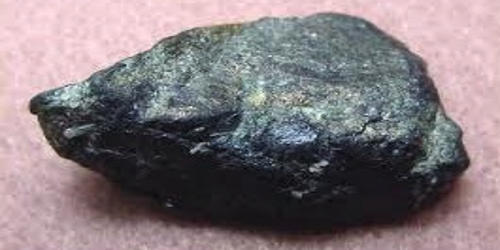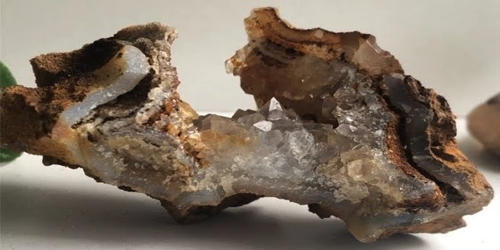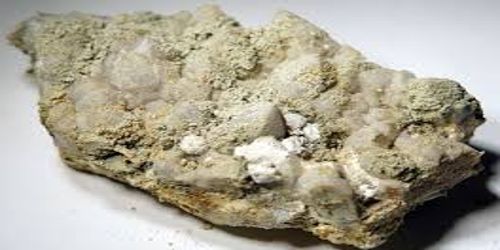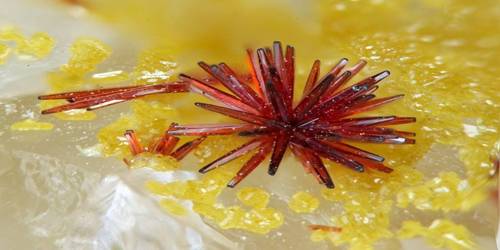Definition –
“Benitoite” (/bəˈniːtoʊaɪt/), is an extremely rare mineral that is best known for being the official state gemstone of California (U.S). Its color is light blue to deep indigo blue. Also bluish-gray and purplish-blue. Maybe zoned with lighter and darker color regions and white zones. It forms in low temperature, high-pressure environments typical of subduction zones at convergent plate boundaries. Benitoite fluoresces under short wave ultraviolet light, appearing bright blue to bluish-white in color. The more rarely seen clear to white benitoite crystals fluoresce red under long-wave UV light.
Benitoite is a barium titanium silicate mineral, usually blue in color, that is found in rocks that have been altered by hydrothermal metamorphism. Its chemical composition is BaTi(Si3O9). Benitoite has a rare 5 pointed twinned crystal form, and an even rarer 6 pointed twinned crystal form, “star of David”.
Benitoite occurs in a number of isolated locations globally, but gemstone quality material has only been found in California at the Benito Gem Mine where it was first discovered. It has been correctly identified in Montana, Arkansas, Japan, and Australia although they formed under slightly different conditions and only grow large enough to be considered an accessory mineral. In 1985 benitoite was named as the official state gem of California.
History of Benitoite: “Benitoite” was first found in Dallas Gem Mine in California. This blue mineral was thought to be sapphire when it was first discovered. Dr. George Louderback was the first person to identify it as a completely different and new mineral in 1907. He named it “Benitoite” as it was found in San Benito County in California, near the headwaters of San Benito River.
Because of its rarity, gemstones and mineral specimens of benitoite are extremely expensive. It is a mineral rarely seen in jewelry or gem and mineral collections.
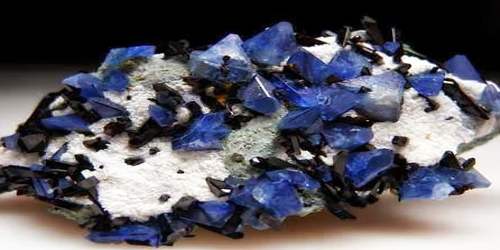
Occurrence and Properties of Benitoite –
Benitoite typically occurs with an unusual set of minerals, along with minerals that make up its host rock. Frequently associated minerals include: natrolite, neptunite, joaquinite, serpentine and albite.
The only significant locality for Benitoite is the Diablo Range, near the headwaters of the San Benito River, in the Southern tip of San Benito County, California. Virtually all collectors specimens for this mineral are from this area. The now-closed Dallas Gem Mine in the Diablo Range has been the source of most of the available material and the largest crystals. Other localities in the area include the Santa Rita Peak, the Victor Claim, the Number One Mine, and the Junnila Mine. In Japan, a very limited occurrence of small gemmy Benitoite is Hashidate, Itoigawa, Niigata Prefecture, Japan.
Location: The benitoite mine is in the southeastern part of San Benito County, near the Fresno County line. The deposit is about 35 miles by road northwest of Coalinga in the Diablo Range, about three-fourths of a mile south of Santa Rita Peak, and on one of the tributaries of San Benito River. The elevation of the mine is about 4,800 feet above sea level; the elevation of Santa Rita Peak is 5,161 feet. The mine is in the end of one of the branching ridges from the south side of Santa Rita Peak. The end of the southward extension of this ridge is a low knob about 160 feet above the creek. This knob is called the apex, and from it a small spur extends to the west down to the creek. The benitoite mine is in the south side of this spur, about 50 feet lower than the apex and 250 feet west of it.
In Japan, ‘Benitoite’ is found in magnesio- riebeckite- quartz- phlogopite- albite dikes that cut a serpentinite body. The gemstone quality Benitoite is only found in California.
Benitoite has a specific gravity of 3.65, compared to a specific gravity of 3.9 to 4.1 for sapphire. Benitoite is usually found in association with other rare minerals, which include natrolite, joaquinite, and neptunite.
Here are some of the basic properties of Benitoite mineral:
- Appearance: The crystals of this mineral have a transparent or translucent appearance.
- Color: This mineral is usually blue in color; however, colorless crystals of this mineral can also be found.
- Molecular Weight: The molecular weight of this mineral is 413.5 gm/mol.
- Crystal Habits: It has tabular dipyramidal crystals.
- Crystal System: It has a hexagonal crystal system.
- Fracture: The crystals of Benitoite have conchoidal fractures.
- Hardness: The hardness of this mineral ranges between 6 and 6.5 on Mohs scale.
- Luster: These crystals have vitreous luster.
- Solubility: It is insoluble in Hydrochloric acid (HCl) and Sulfuric acid (H2SO4) but soluble in Hydrofluoric acid (HF).
- Density: It has the density of 3.6 gm/cm3.
- Specific Gravity: Its specific gravity is 3.6.
- Streak: The streak of this mineral is white.
- Optical Property: Benitoite has uniaxial optical property.
- Refractive Index: nω = 1.756 – 1.757 nε = 1.802 – 1.804
- Birefringence: δ = 0.046
Benitoite is insoluble in ordinary acids but is attacked by hydrofluoric acid and dissolves infused sodium carbonate. Alone, it fuses quietly to a transparent glass at about 3. The color of benitoite is not affected by heating the stone to redness and allowing to cool. The hardness is greater than orthoclase and less than peridot, or about 6 to 6 1/2, and the specific gravity is 3.64 to 3.67.
Uses of Benitoite –
Benitoite is cherished by collectors as a rare and valuable mineral. It is also cut as as an exquisite rare gemstone. The size of the gems cut from benitoite range in weight from a small fraction of a carat to several carats. According to Doctor Louderback the largest perfect stone so far cut weighs over 7 carats and is about three times as heavy as the next largest flawless gem so far obtained. The majority of larger cut stones weigh from 1 1/2 to 2 carats.
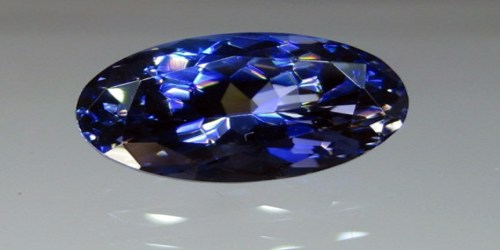
The principal production is in stones weighing less than 1 1/2 carats. The use of benitoite in rings or jewelry subjected to hard wear is limited by its comparative softness. The beautiful color, brilliancy, and fire of the gem, however, adapt it to other classes of fine jewelry. Since the supply of benitoite is thought to be limited and a fairly large demand has already arisen for the gem, it is probable the price will be kept high, possibly as high as that of sapphire, its nearest rival in color.
Another important use of Benitoite is as a mineral specimen. The unique crystals of this mineral are highly valuable as collectable specimens. It is also used as a minor barium and titanium ore.
Information Sources:
